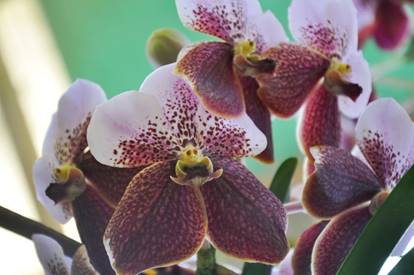
Photo Credit – U.S. Navy National Museum of Naval Aviation
Kurita emerged unopposed
from the San Bernardino Strait and was racing southward heading for Leyte Gulf.
At daybreak on October 25, American carriers were sighted on the horizon.
Kurita thought he had caught Halsey’s fast carriers with most of their planes
down. In fact, Halsey was 300 miles to the north and his planes were taking off
to attack Ozawa’s Northern Force. Ozawa radioed Kurita that he was under attack,
but Kurita never received the message.
What Kurita had come
upon was Rear Admiral Clifton A.F. Sprague’s Taffy 3, one of three groups of
escort carriers from Kinkaid’s Seventh Fleet assigned to provide air cover and
antisubmarine patrol for the Leyte landings, not to attack enemy warships.
When one of his pilots
reported seeing enemy forces closing in at 30 knots, Adm. Clifton “Ziggy”
Sprague aboard his flagship, the Fanshaw Bay, ordered him to check
identification. “Ships have pagoda masts”, came the reply. Sprague wasted no
time. He swung his carriers east into the wind at top speed and launched every
operational plane, including his fighters. He instructed all ships to throw up
smoke screens, alerted his destroyers to prepare for an attack, and radioed for
help.
Within minutes, Kurita
was dropping salvos all around the American ships. Giant splashes of dyed water
rained down in yellow, red, purple, and green on the decks of the jeep
carriers. Then Providence intervened; a rain squall appeared, and Taffy 3
ducked into it.
For the next three
hours, while Taffy 3 broadcast repeated calls for help and Kinkaid frantically
radioed Halsey to return south, Sprague eased southward with his carriers,
executing a series of brilliant evasive maneuvers. The counterattacks by his
aircraft and seven fighting ships were so fierce, so concentrated, and so
effective that the Japanese continued to believe that they were engaging a much
bigger force.
Under the shaky cover of
the planes, Sprague’s destroyers and destroyer escorts recklessly threw
themselves in front of their carriers. They kept on firing torpedoes, and
though few of the missiles found their marks, the misses served to delay and
distract the faster Japanese ships.
The destroyer Johnston,
under the command of Cmdr. Ernest Edwin Evans, a mixed-blood Cherokee Native
American from Oklahoma, was in the thick of the hectic fight all morning. She
fired her last torpedoes just before being hit by three 14-inch shells. Three
small shells tore into the hull. A rain squall covered her while her crew made
emergency repairs. When the Johnston emerged from a cloud of smoke, she found
herself bow to bow with a Japanese battleship. Firing as she went, she ducked
back into the smoke and soon came upon the crippled American cruiser Gambier
Bay, which was under attack by a Japanese cruiser. Realizing that the
carrier was damaged too severely to flee, Evens rushed in with guns blazing to
draw off the cruiser, but the Japanese, intent on larger prey, ignored the
Johnston.
At this point, a line of
five Japanese warships bore down upon the Gambier Bay and her
companion carriers. The Johnston turned around, and Evans
fired at the Japanese column. He hit a light cruiser. Japanese shells came from
every direction until the Johnston was hit and later sunk. A wounded Evans
vanished with his sinking ship. The destroyer escort Samuel B. Roberts also
went down in this phase of battle while planes from all three Taffys swarmed
Kurta’s ships. Then, as the Japanese destroyers turned away, Kurita’s fast
cruisers began to close in on Sprague’s carriers. The Gambier Bay was
starting to sink, but she continued to blaze away with her single 5-inch gun.
The destroyer and
destroyer escorts had the duty to protect the carriers. In this battle, led by
the Johnston, they went far beyond the call of duty. After making a
smokescreen to obscure the escort carriers, the Johnston charged
the oncoming Japanese fleet. Evans waited until his ship got within eight
hundred yards of the leading Japanese ship before firing his torpedoes. A
torpedo ripped into the Kumano, flagship of one of Kurita’s
cruiser divisions.
Admiral Kincaid
frantically called on Halsey as he feared the loss of his escort carrier fleet
to Kurita’s fleet. Admiral Nimitz followed the progress of the battle from
Hawaii by wireless telegraph. He was concerned by Halsey’s dispatch at 8:24 pm
the night before: “am proceeding north with three groups.” Kincaid’s desperate
pleas the morning of October 25 caused Nimitz to be even more perturbed. He
sent a message to Halsey: “Where is Task Force Thirty-Four? Repeat, where is
Task Force Thirty-Four? The world wonders.” Halsey felt insulted by Nimitz’s
inquiry. Shortly thereafter, he gave the order to change course from due north
to due south. He did not expect his fleet to arrive at Leyte Gulf until 8 am
the next morning, too late to engage Kurita’s fleet.
A memorial to Sprague and Taffy 3 next to USS
Midway (CV-41) in San Diego
Photo Credit – Wikipedia.org
Clifton Sprague’s force
put up a gallant and heroic fight against a superior force. Yet, before being
annihilated, Kurita’s mighty squadron, astonishingly, was forced to turn and
flee northward through the San Bernardino Strait. The sight of Kurita’s
departing force left Sprague dumbfounded.
Taffy 3, incredibly, had
outfought and outlasted an overwhelmingly superior enemy – and, in doing so,
had kept the heavy guns of the Japanese fleet off the American troop transports
and MacArthur’s beachhead on Leyte. Admiral Sprague credited Taffy 3’s survival
to “our successful smoke screen, our torpedo counterattack, continuous
harassment of the enemy by bomb, torpedo, and strafing air attacks, timely
maneuvers, and the definite partiality of Almighty God.”
Sources:
The Pacific War by
William B. Hopkins
Return to the Philippine
WWII by Rafael Steinberg









